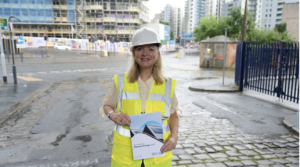Can we create a digital commons in 2015?
 Imagine this. It’s 2025 and communities across the country have assumed a greater role than ever before in shaping their futures. The step-change in the transfer of land and buildings from the state over the preceding decade served as a fulcrum for the leveraging of community ambition and evidencing capability. The benefits flowing from the community ownership and management of broad-ranging assets is now widely acknowledged, and it is the default position for ‘assets of community value’.
Imagine this. It’s 2025 and communities across the country have assumed a greater role than ever before in shaping their futures. The step-change in the transfer of land and buildings from the state over the preceding decade served as a fulcrum for the leveraging of community ambition and evidencing capability. The benefits flowing from the community ownership and management of broad-ranging assets is now widely acknowledged, and it is the default position for ‘assets of community value’.
Exploiting new opportunities with increasing confidence, communities are readily and successfully adopting community enterprise to nurture sustainable growth and deliver social impact. Local government has played a pivotal role in encouraging this dynamic and forward-looking change in the community paradigm, enabling and empowering citizens to take greater control and improve their resilience one neighbourhood at a time.
Local businesses contribute professional expertise to community asset development initiatives in recognition of the potential for mutual benefit. In the face of sustained challenges, too, communities have acknowledged the need for new ways of working, accessed appropriate support and embraced the opportunity to effect change for themselves – each in their own way. Civic pride and a renewed community spirit underpin cross-sector visions for places and enable positive and pre-emptive action at the local level.
The new climate of shared responsibility and trust has transformed the stewardship and development of key infrastructure – whether in safeguarding public open space and cultural assets, in building affordable homes and alternative broadband schemes, or in re-establishing the local foundations of health and justice-related assets for community benefit. It now underpins holistic local-by-default services that dramatically improve outcomes for the most vulnerable. Blight and redundancy are no longer permitted. Communities are empowered to take action to restore productive uses. Enterprise assets with viable uses are found in every community – contributing to social, economic and environmental renewal, and generating surpluses for reinvestment at the local level.
In 2015, community asset ownership needs to evolve and embrace the potential
for communities to generate wealth through the deployment of new and emergent digital technologies
Community ownership is democratised, with residents taking a direct stake through, for example, community share issues, crowd funding and mutual governance structures. It is also forward-looking – harnessing technological advancements to infuse the digital landscape with a Commons ethos through the development of community networks that are oriented towards the deployment of less tangible assets for social, economic and environmental purposes. These networks are, in turn, underpinned by cooperative approaches to data stewardship and deployment, as well as collective intellectual property development and management against the backdrop of growth in the sharing economy.
So, how do we travel from here to there?
The learning amassed over the course of the past decade points to the need for time, capacity, appropriate skills, support and investment, as well as effective partnership working across sectors as critical success factors.
It also underlines the benefits that flow from stimulating positive and proactive encounters between central and local government and communities, rather than building upon a deficit model or default position of ‘save our…’ in the face of ongoing pressures to dramatically reconfigure the public estate.
Crucially, it calls for the development of a shared vision for the future – for people as well as places – which readily acknowledges the role that government, business and communities must play if we are to meet the unprecedented challenges we face at present with the requisite energy and generosity of spirit that will be needed to achieve mutual benefit.
What stands in our way?
Caution needs to be exercised where community asset acquisition provisions with a long-track record (as per community asset transfer) continue to be championed in challenging socio-economic circumstances. There may, for example, be limits to established business models that have long-since rendered community asset ownership viable and sustainable – in particular, in deprived communities, where the combination of diminishing high quality revenue streams from public sector anchor tenants and service contracts are concerned. We should acknowledge the very tangible progress made in raising awareness of the potential for community asset ownership to deliver social benefit in England over recent years. But, we still have much to learn from land reform proposals and relevant agencies in Scotland as well as other international developments – in particular, those concerned with contemporary approaches to so-called ‘stewardship of the commons’, in the broadest sense of the term.
There are potentially very significant opportunities harbored by the ‘sharing economy’ or ‘collaborative consumption’ movements, if and when they are adapted to prevent them from doing damage to localities and their different strengths and weaknesses. We are already witnessing cutting-edge work in, for example, Bologna in this regard. And, herein, may lie the scope for a broader conception of place-based regeneration to emerge – one which engages active citizens and enables them to deploy the range of public assets (land, buildings, tools, skills, digital infrastructure) in new ways to deliver community benefit. Indeed, our own government has recently published an encouraging report which seeks to promote and take forward the sharing of tangible assets in the UK in earnest.
However, in NCVO’s The Road Ahead – 2014, Karl Wilding remarked that, ‘a doomsday scenario remains of the digitally excluded supported by the digitally challenged’. And, it is ever more apparent that we lack government buy-in to the scope for communities and their not-for-private profit representatives to modernize – let alone, innovate using technology to improve their efficiency, appeal to younger generations and increase their social impact. We need, then, to redress the imbalance of investment flowing to public and private sector bodies to take advantage of the opportunities that are harbored by the range of new technologies. It is also incumbent upon the sector itself to accept and get to grips with the potential for technology to benefit those communities it seeks to serve in new ways.
It may be that, looking ahead, the viability of more traditional community owned land and built asset initiatives will rest upon the successful marrying of tangible with intangible asset ownership and management propositions for social benefit – whether they be community managed ICT networks or digital enterprises. At the very least, this possibility surely warrants greater attention over the coming year. That is why we are pioneering new approaches to community-based knowledge assets in the course of our own work concerning Common Libraries. We are also exploring whether the community ownership of data might be pursued through the establishment of Data Coops explicitly for community benefit. But, what is needed going forward is a groundswell of interest from communities and third sector organisations themselves, matched by reciprocal interest from government.
We have only begun to scratch the surface of what may be possible in a bid to encourage others to date. Who knows what the Internet of Things could do to add value to organisations pioneering interventions to support older people living with dementia and their families? Equally, what could 3D printing or, even, nanotechnology do to revolutionise the production of necessities – including more affordable, energy efficient homes – for those communities we are all busy working to empower? In 2015, community asset ownership needs to evolve and embrace the potential for communities to generate wealth for the common good as they always have done – through the development of land and buildings – but also through the deployment of new and emergent digital technologies.
Five ways to create a digital commons in 2015
- We need to raise awareness and aspirations amongst communities about the potential for new technologies to add value to more traditional community-led asset and enterprise development initiatives;
- We need recognition of the potential for community owned ICT networks to dramatically impact digital inclusion and, with that, improve upon more traditional approaches to ‘assisted digital’;
- We need government to acknowledge that substantive investment in support for digital enterprise development – by and for community benefit – is paramount, if the third sector is to modernize and innovate to increase its social impact;
- We need support to empower and enable communities eager to take an international lead in establishing community owned #data4good initiatives; and
- We need communities themselves to step up to the challenge – grow their confidence, capacity and skills – such that they are empowered to (really) do different at a time when paradigm shift is no longer desirable so much as essential.















